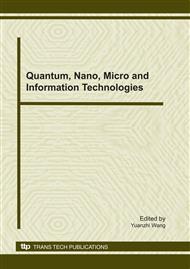[1]
A. Fujishima, T. N. Rao, D. A. Tryk, J. of Photochem. Photobiol. C: Photoc. Rev. 1 (2000) p.1.
Google Scholar
[2]
G.S. Shao, X.J. Zhang, Z.Y. Yuan, Appl. Catal. B-Environ. 82 (2008) p.208.
Google Scholar
[3]
J.L. Gole, J.D. Stout, C. Burda, Y. Lou, X. Chen, J. Phys. Chem. B108 (2004) p.1230.
Google Scholar
[4]
C.H. Kwon, H. Shin, J.H. Kim, W.S. Choi, K.H. Yoon, Mater. Chem. Phys. 86 (2004) p.78.
Google Scholar
[5]
R. Asahi, T. Morikawa, T. Ohwaki, K. Aoki and Y. Taga, Science 293 (2001) p.269.
Google Scholar
[6]
Y. Suda, H. Kawasaki, T. Ueda, T. Ohshima, Thin Solid Films 453-454 (2004) p.162.
Google Scholar
[7]
M.C. Yang, T. S., Yang, M. S. Wong, Thin Solid Films 469-470 (2004) p.1.
Google Scholar
[8]
S.Z. Chen, P.Y. Zhang, D.M. Zhuang, W.P. Zhu, Catal. Comm. 5 (2004) p.677.
Google Scholar
[9]
Z. Ding, X. Hu, P.L. Yue, G.Q. Lu, P.F. Greenfield, Catal. Today 68 (2001) p.173.
Google Scholar
[10]
Y.H. Tseng, C.S. Kuo, C.H. Huang, Y.Y. Li, P.W. Chou, C.L. Cheng, M.S. Wong, Nanotechnology 17 (2006) p.1.
Google Scholar
[11]
P.K. Song, Y. Irie, Y. Shigesato, Thin Solid Films 496 (2006) p.121.
Google Scholar
[12]
M. Yamagishi, S. Kuriki, P.K. Song, Y. Shigesato, Thin Solid Films 442 (2003) 227-231.
DOI: 10.1016/s0040-6090(03)00987-8
Google Scholar
[13]
J. Zhu, Z. Deng, F. Chen, J. Zhang, H. Chen, M. Anpo, J. Huang, L. Zhang, Appl. Catal. B-Environ. 62 (2006) p.329.
Google Scholar
[14]
L. Miao, S. Tanemura, S. Toh, K. Kaneko, M. Tanemura, J. of Crystal Growth 264 (2004) p.246.
DOI: 10.1016/j.jcrysgro.2003.12.027
Google Scholar
[15]
T.L. Hanley, V. Luca, I. Pickering, R.F. Howe, J. Phys. Chem. B 106 (2002) p.1153.
Google Scholar
[16]
A. Rampaul, I.P. Parkin, S.A. O'Neill, J. DeSouza, A. Mills, N. Elliott, Polyhedron 22 (2003) p.35.
Google Scholar
[17]
Y. Yang, X.J. Li, J.T. Chen, L.Y. Wang, J. Photochem. Photobiol. A-Chem. 163 (2004) p.517.
Google Scholar
[18]
S. Takeda, S. Suzuki, H. Odaka, H. Hosono, Thin Solid Films 392 (2001) p.338.
Google Scholar
[19]
N.L. Wu, M.S. Lee, Z.J. Pon, J.Z. Hsu, J. Photochem. Photobiol. A-Chem. 163 (2004) p.277.
Google Scholar
[20]
S.C. Jung, S.J. Kim, N. Imaishi, Y.I. Cho, Appl. Catal. B-Environ. 55 (2005) p.253.
Google Scholar
[21]
N.C. Saha, H.G. Tompkins, J. Appl. Phys. 72 (1992) p.3072.
Google Scholar
[22]
S. Tanemura, L. Miao, H. Watanabe, Y. Mori, Appl. Surf. Sci. 244 (2005) p.546.
Google Scholar
[23]
G. -S. Herman, Y. Gao, T.T. Tran, J. Osterwalder, Surf. Sci. 447 (2000) p.201.
Google Scholar
[24]
F.H. Lu, S.P. Feng, H.Y. Chen, J.K. Li, Thin Solid Films 375 (2000) p.123.
Google Scholar
[25]
I. Milošev, H. -H. Strehblow, B. Navinšek, Surf. Coat. Tech. 74-75 (1995) p.897.
Google Scholar


